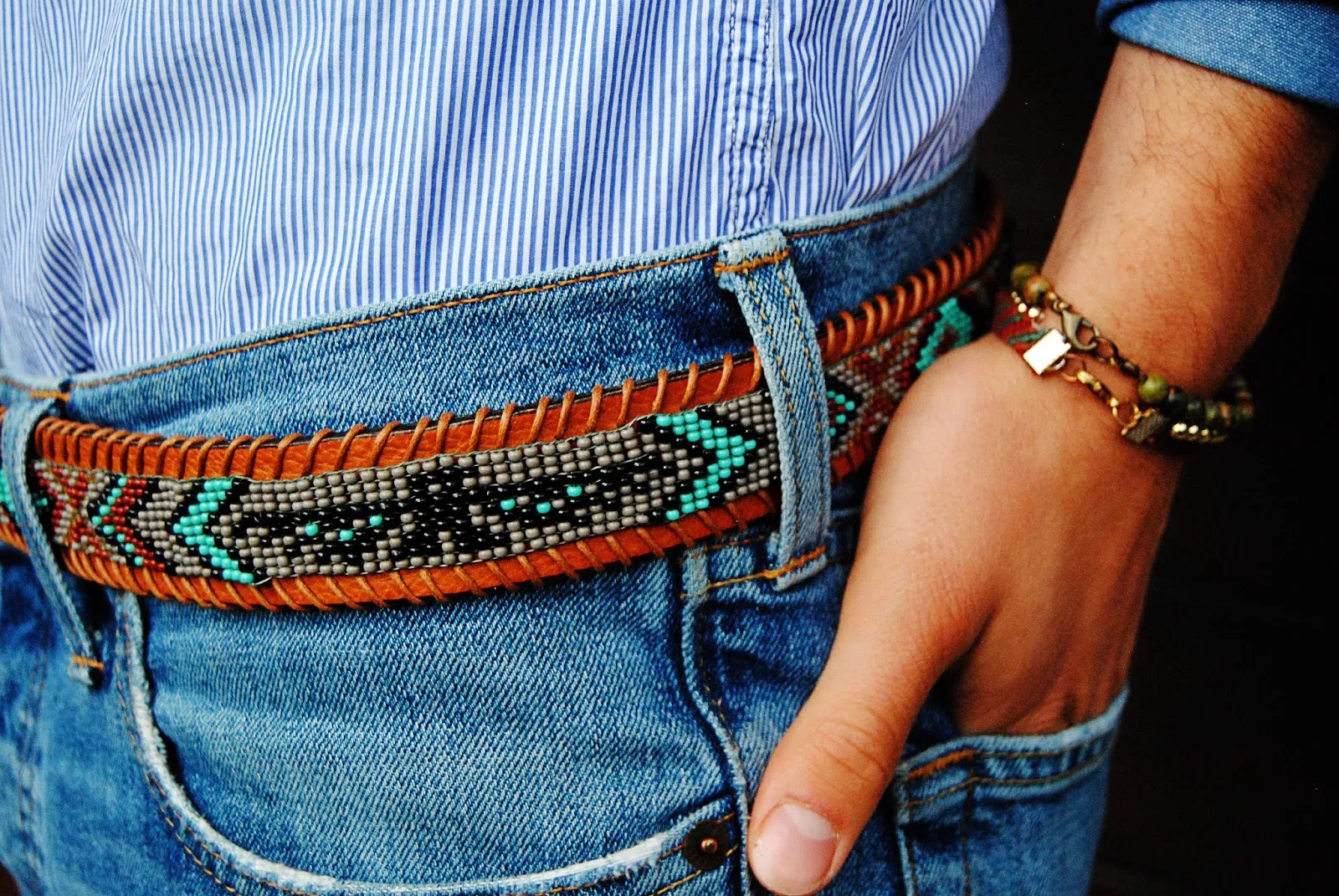In the intricate world of Native American craftsmanship, few pieces of regalia are as captivating and meaningful as men’s beaded belts. These meticulously handcrafted belts are more than just accessories; they are a testament to the rich cultural heritage of indigenous communities.
Adorned with vibrant beads and traditional designs, these belts are a visual embodiment of history, storytelling, and artistic expression. In this exploration, nativeamericanclothes.com unveil the artistry, significance, and craftsmanship behind Native American men’s beaded belts, weaving a narrative of tradition and style.
Why is beading important in Native American culture?

In Indigenous communities, beading transcends the mere act of crafting; it embodies culture, identity, and a profound sense of well-being. This art form, passed down through generations, offers a unique blend of therapeutic practice and artistic expression, reflecting the resilience and strength of Indigenous peoples.
Beading circles, gatherings where individuals collectively create beadwork, foster connections, renew cultural bonds, and contribute to holistic healing. Through this intricate craft, relationships with ancestral heritage, land, and community are nurtured.
Embracing Ancestral Ties Through Beading
Beading serves as a powerful link to ancestors and traditions. For many Indigenous artists like Elvira Nowlin, beading is a means to connect with their forebears. The creative process enables them to feel a profound closeness to their roots and reinforces the idea that beading is not just a solitary activity; it is about building relations – with one’s heritage, with fellow beaders, and with the earth.
Creating Community through Beading Circles
Beading circles are at the heart of this art, providing a communal space where people come together to create and connect. As the beads are meticulously woven into patterns, conversations flow, and kinship deepens. Even when working on individual pieces, beaders within a circle influence one another’s work, weaving connections that mirror the intricate beadwork itself. These circles become a source of collective sharing and community building.
Caring for the Self, the Community, and the Land

Beading encompasses ethical sourcing, as Indigenous artisans often gather materials from their lands. This mindful and sustainable approach to crafting becomes an act of decolonial care and responsibility. Through beading, Indigenous peoples nourish not only themselves and their communities but also their lands.
As a form of therapeutic art, it acts as a healing balm for individuals, helping them navigate mental health challenges and homelessness, as attested by many.
Beading as Therapeutic Art
Indigenous beading, as a therapeutic art, has not always been widely recognized in psychotherapeutic research, unlike mainstream art therapy. Yet, its healing potential is evident within Indigenous communities. This unique blend of culture, craft, and therapy underscores the value of beading as an instrument for self-expression, cultural preservation, and individual and collective well-being.
The healing power of Indigenous beading lies in its ability to weave the threads of tradition, culture, and community into a vibrant tapestry of well-being and identity. Beading circles are not just places to create art; they are gatherings of resilience, cultural pride, and healing.
What do Native American beads mean?
Jewelry, beyond its sheer beauty, held profound social, economic, political, and religious significance for the Native Americans of southern New England during the 1600s. It was more than ornamental; it was a reflection of their identity and a medium for various aspects of life.
Personal Aesthetics: The Art of Adornment
For Native Americans in New England, especially young women, adornment with beads and pendants was an essential element of personal aesthetics. Wampum beads, in particular, were highly prized, and substantial quantities of jewelry were worn.
Interestingly, Native American women were considered less vain than their European counterparts. In addition to personal adornment, beads found their way into clothing and were artfully inlaid into wooden objects for aesthetic purposes, such as tomahawk handles, pendants, and bread mixing bowls.
Group Identity: Connecting Through Totems
In many northeastern tribes, individuals acquired spiritual totems, often representing animals or animal parts, during adolescence. These totems were not just personal; they also signified affiliation with one’s family, clan, or society.
Jewelry became a means for Native Americans to signal their group identity. For instance, a male cat’s head wrapped in trade cloth served as one such totem. These totems had a role in divination and ensured opportunities. By wearing beads and pendants, Native Americans visually conveyed their role within their social, economic, political, and cosmological framework.
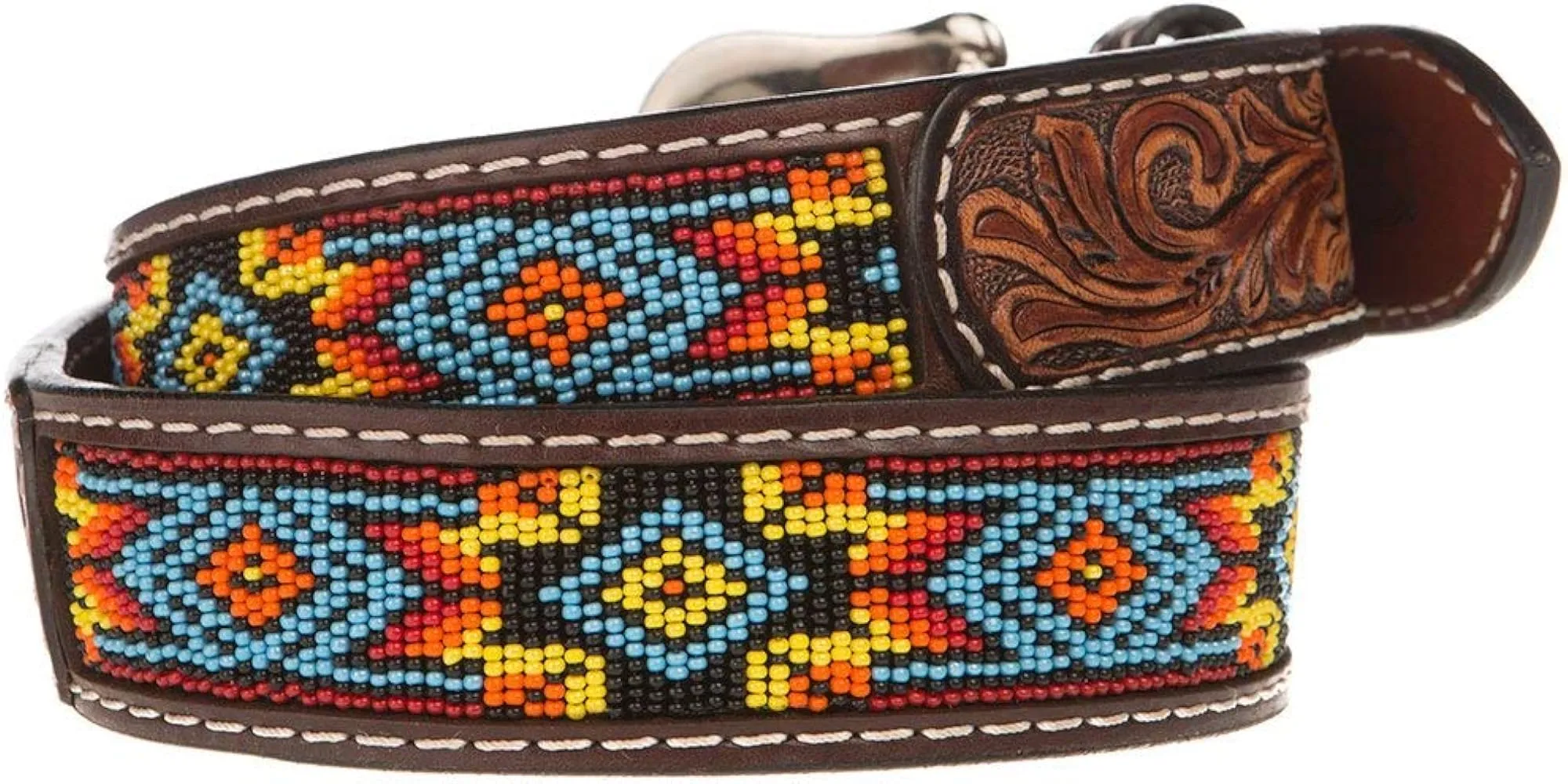
Exchange and Currency: Wampum as a Symbol of Reciprocity
Wampum beads were an integral part of the reciprocal gift exchange system in New England. They adorned high-status men and young women within tribes, symbolizing ties within Native American communities. With European contact, trade networks expanded, enabling the exchange of wampum inland, as far as Wisconsin and the Dakotas, and as far south as Virginia.
Wampum beads evolved into a formal currency, particularly with the scarcity of metal coins.
European traders and politicians often exploited gift exchanges using beads and trinkets to secure Native American favor or land. It was even mass-produced by the Dutch, remaining in use until the American Revolution.
Ceremonies: Ritual Integration
Beads and pendants were seamlessly integrated into various Native American ceremonies. These were more than mere ornaments; they were elements of ritual expression, reflecting Native American reverence for minerals, metals, and shells.
Dance ceremonies marked seasonal changes, harvests, births, marriages, and commemorated important events. Chanting often accompanied these dances. Native Americans took great care in their appearance and accessories during these ceremonies, often throwing out wampum to onlookers.
Ceremonies of healing and curing incorporated specific jewelry or ornamentation, such as shells from various animals. Necklaces could provide protection against particular disorders. Face-painting with red and the use of hair ornaments in the same color were associated with curing ceremonies. Jewelry and personal items were often relinquished or destroyed as part of sacrifices during these rituals.
Rites of Passage: Marking Transformation
Jewelry played a vital role in indicating that individuals had gone through significant physical or social changes, also known as rites of passage. An example was a Native American woman marking her transition into womanhood after her first menses.
After months of veiling, women would replace the covering with necklaces, belts, and wampum headbands. Beads were also an integral part of marriage rituals, serving as bridal presents, with some including wampum, Dutch glass, and other beads. Funeral and mortuary customs were not exempt from jewelry’s importance. The deceased often wore necklaces, bracelets, rings, headbands, and other ornaments provided by relatives.
Jewelry was not just a superficial adornment; it was a tapestry woven with the threads of tradition, identity, culture, and spirituality for Native Americans in southern New England during the 17th century. It told stories of connection, reciprocity, and transformation, reflecting the vibrant tapestry of their lives.
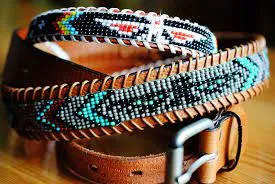
See more: Native American Vest Mens
What are the two different types of Native American beadwork?
Beadwork, an age-old art form embedded in the traditions of Native American tribes, represents a vibrant spectrum of creativity and cultural expression. Each tribe tells its unique story through distinct designs, colors, patterns, and techniques, weaving a colorful tapestry of heritage.
The Versatile World of Beading
Beadwork is a multifaceted art, with various styles that distinguish it. Among these styles, the lazy stitch (also known as the lane stitch) and the tack stitch stand out as two prominent techniques, each carrying its own historical and artistic significance.
Lazy Stitch: Tradition Woven with Beads
The lazy stitch is deeply rooted in the cultural heritage of the Great Plains region. It’s one of the more traditional styles of beading that Native American tribes have employed for generations. This method has left its mark on clothing and the traditional regalia of Native American people.
Lazy stitch beadwork is characterized by rows of beads arranged in lanes, often accommodating up to nine beads at a time. This style serves as the canvas for various geometric designs that showcase the tribe’s identity and heritage.
Tack Stitch: The Art of Precision
In contrast, the tack stitch is a technique embraced by artisans for more intricate and circular designs. It offers a smooth and flat finish to the touch, exemplifying precision and detail. Tack beading has gained popularity among contemporary artists who appreciate its refined aesthetics. It’s a testament to the evolution of beading in response to the changing times.
The Diversity of Beaders

The world of Native American beadwork is as diverse as the tribes it represents. It encapsulates both the unwavering commitment of artists who preserve traditional beading teachings passed down by tribal elders and the adaptability of those who embrace the evolving trends of modern culture.
Just as the landscapes and cultures of Native American tribes differ, so do the styles and techniques of beadwork. Each beadwork artist carries a unique signature that resonates with their individuality and creativity.
Beadwork is more than an art form; it’s a testament to the enduring spirit of Native American tribes. It encapsulates history, identity, and innovation, allowing these communities to celebrate their heritage while adapting to the ever-changing world. Through beads, they continue to tell their stories, one stitch at a time.
What are the different types of Native American beading?
Beadwork holds a special place in the rich cultural tapestry of American Indian communities in Oklahoma. Among the numerous techniques and styles cherished by these indigenous artisans, four major types of beadwork stand out, each with its unique characteristics and applications.
These include the lazy stitch, loom work, appliqué, and net techniques. In this exploration of Native American beadwork, we delve into the significance and uses of these techniques.
Lazy Stitch: A Masterpiece of Coverage
The lazy stitch is a prominent technique extensively used in Oklahoma’s Native American communities. In this method, artisans attach small strings of beads to the base material at each end, creating a visually stunning and intricate pattern.
Lazy stitch is often employed to cover substantial surface areas on various items, such as dresses, moccasins, cradleboards, and horse gear. Its versatility and capacity to adorn both functional and ceremonial items make it an integral part of Native American beadwork in the region.
Loom Work: Weaving Stories and Art
Loom work is another remarkable facet of Native American beadwork, allowing artisans to weave intricate tales and artistic designs into their creations. By using a loom, beadworkers meticulously string together rows of beads to form patterns and images. This technique is commonly employed to craft items like belts, sashes, and headbands. Loom work is a testament to the precision and artistry of Native American beadwork in Oklahoma.
Appliqué: Precision and Elegance
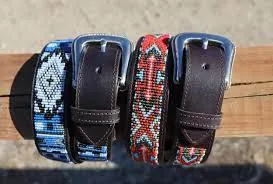
The appliqué technique is characterized by its precision and elegance. In this method, artisans carefully attach beads directly onto the surface of the base material, creating intricate designs and patterns. Appliqué is often used to embellish clothing, regalia, and various ceremonial items. It allows for the creation of captivating and visually striking pieces that play a significant role in cultural and ceremonial events.
Net Techniques: A Delicate Web of Artistry
Net techniques involve the creation of delicate and intricate beadwork patterns that resemble fine nets. These patterns are often used to adorn items like purses, bags, and other functional pieces. The net technique showcases the beadworkers’ ability to combine artistry with functionality, resulting in visually captivating and practical items.
Preserving a Legacy of Art and Culture
Native American beadwork in Oklahoma is more than an art form; it’s a means of preserving a rich legacy of culture, tradition, and history. These intricate beadwork techniques serve as a visual language, telling stories, representing identities, and celebrating the vibrant heritage of indigenous communities. As these techniques continue to evolve and adapt to contemporary styles, they remain a vital part of Oklahoma’s cultural landscape.
In the heart of these beadwork techniques lies a profound connection to the past, a celebration of the present, and a bridge to the future. They are a testament to the enduring spirit of Native American communities, ensuring that their stories and traditions are passed down through the generations. The beadwork of Oklahoma’s American Indians is a living art form, a reflection of heritage, and a source of pride.
Native American Mens Beaded Belts
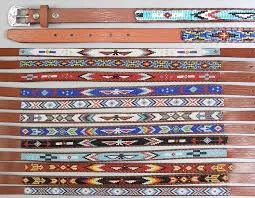
Beaded belts have long been an integral part of Native American culture, and their significance extends beyond mere fashion. These handcrafted pieces are not only stylish but also bear cultural and historical importance.
Native American men’s beaded belts are a testament to the artistry and craftsmanship of indigenous communities. In this exploration, we delve into the world of these distinctive accessories, uncovering their cultural significance, craftsmanship, and the stories they tell.
A Glimpse into Native American Beadwork
Beadwork is a revered tradition in Native American culture, and it holds a special place in the hearts of indigenous artisans. The art of beading is a meticulous and time-honored practice, with each beadwork piece telling a unique story. These intricate designs often draw inspiration from nature, tribal symbolism, and the rich history of Native American communities.
The Cultural Significance of Beaded Belts
Beaded belts are more than just accessories; they are symbols of cultural pride and identity. These belts often feature traditional designs and colors that are specific to the wearer’s tribe. They are a source of deep cultural pride, reflecting the heritage and traditions of Native American communities.
The Craftsmanship Behind Beaded Belts
The creation of a beaded belt is a labor of love. Skilled artisans dedicate hours, sometimes even days, to meticulously hand-sew each bead onto the belt’s fabric. The intricate patterns and designs are a testament to the artisan’s expertise and commitment to preserving their cultural heritage. Every bead is carefully chosen for its color, size, and shape, ensuring that it fits perfectly within the overall design.
A Versatile Accessory
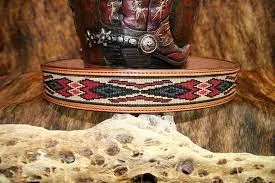
Native American men’s beaded belts are not only aesthetically pleasing but also versatile. They can be worn on various occasions, from powwows and cultural ceremonies to everyday life. These belts are often adorned with symbols and motifs that hold special meaning for the wearer, making them deeply personal and significant.
Connecting Past and Present
Beaded belts are a bridge between the past and the present. They connect modern Native Americans with their ancestors, as many of the traditional designs and techniques have been passed down through generations. Wearing a beaded belt is a way of honoring the cultural heritage and keeping the traditions alive.
Supporting Indigenous Artisans
When you invest in a Native American men’s beaded belt, you are not just acquiring a beautiful accessory; you are also supporting indigenous artisans and their communities. Many indigenous artisans rely on the sale of their beadwork to sustain their way of life and preserve their cultural traditions.
Native American men’s beaded belts are more than fashion statements; they are living symbols of culture, tradition, and artistry. Each belt is a unique piece of history, reflecting the rich heritage of Native American communities. By wearing one of these belts, you not only enhance your style but also become part of a story that spans generations. It’s a powerful way to celebrate and honor the enduring legacy of indigenous cultures.

